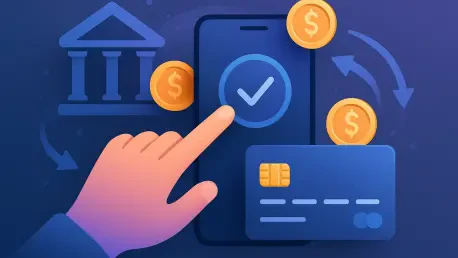Imagine a world where securing a concert ticket, placing a quick bet, or grabbing a last-minute online deal happens faster than you can blink, with no waiting for payments to process, thanks to the incredible advancements in financial technology that have made this a reality. Instant transactions, powered by real-time payment systems through digital wallets and mobile apps, are seamlessly blending finance with entertainment, creating experiences that captivate users across platforms like e-commerce, gaming, and streaming. This isn’t merely about speed—it’s a fundamental shift in how digital interactions unfold, offering unparalleled convenience and engagement. From slashing friction in transactions to opening new doors for global participation, fintech is rewriting the rules of fun. As this transformation accelerates, the impact touches consumers and businesses alike, raising questions about security and the future of integrated payments. Let’s explore how this dynamic synergy is reshaping industries and what lies ahead on this exciting journey.
The User Experience Revolution
Speed as the Game-Changer
Instant transactions are fundamentally altering how users engage with digital platforms by eliminating the frustration of wait times, and their impact is evident across various sectors. In industries like online gambling, platforms that provide rapid withdrawals have seen customer retention rates increase by an impressive 5%, translating into profit surges ranging from 25% to 85%. This isn’t a minor improvement; it’s a clear signal that speed is a non-negotiable factor in keeping users invested. Particularly among Gen Z, a striking 78% prioritize fast payment options, reflecting a broader expectation of immediacy in all digital interactions. When payments happen in real-time, whether it’s a subscription renewal or an in-game purchase, the seamless flow keeps users immersed in the experience rather than bogged down by delays. This trend underscores a shift in consumer behavior, where patience for processing times is dwindling, and platforms must adapt to meet these heightened demands for instant gratification.
Beyond retention and engagement, the ripple effects of speed touch every corner of digital entertainment and commerce. Consider e-commerce, where one-click payment solutions have slashed cart abandonment rates from a staggering 70% to under 1%. This dramatic reduction highlights how removing transactional friction can directly boost conversion rates, turning casual browsers into committed buyers. For streaming services, instant payments mean uninterrupted access to content, ensuring users don’t miss a moment due to payment hiccups. The competitive edge gained by platforms prioritizing speed cannot be overstated—those who lag behind risk losing market share to rivals who deliver on the promise of immediacy. As consumer expectations continue to evolve, the pressure is on for industries to integrate real-time payment systems not just as a feature, but as a core component of their user experience strategy.
Engagement Through Simplicity
The simplicity of instant transactions is a powerful driver of user engagement, creating a hassle-free environment that keeps people coming back for more seamless experiences. When a payment is processed with a single tap on a mobile device, it strips away the complexity that often deters users from completing transactions. This ease is especially critical in fast-paced settings like live event ticket sales, where a delayed payment could mean missing out on a coveted spot. Digital wallets such as Apple Pay and PayPal have become go-to solutions, offering a streamlined process that doesn’t require entering card details repeatedly. By reducing the steps needed to finalize a purchase, these tools enhance the overall enjoyment of digital interactions, making them feel effortless and intuitive for users across demographics.
Moreover, simplicity in transactions fosters a sense of reliability that builds long-term loyalty among users. When payments are instantaneous and error-free, trust in the platform grows, encouraging repeat interactions. This is particularly evident in subscription-based entertainment models, where automatic renewals processed in real-time prevent service interruptions and maintain a smooth user journey. For younger audiences like Millennials and Gen Z, who value efficiency above all, this reliability is a key factor in choosing which platforms to engage with regularly. Businesses that fail to prioritize such seamless experiences risk alienating these tech-savvy consumers, who are quick to switch to competitors offering a more fluid payment process. As fintech continues to refine these systems, the bar for user-friendly transactions will only rise, pushing industries to innovate relentlessly.
Accessibility and Inclusion
Breaking Down Barriers
Mobile payment systems are dismantling traditional obstacles, enabling a broader range of individuals to participate in digital entertainment and commerce without the need for conventional bank accounts. This shift is particularly transformative in regions where banking infrastructure is limited, allowing users to access platforms using just a smartphone and a digital wallet like Skrill or PayPal. Businesses that embrace a variety of payment methods—often six or more—report significantly higher customer satisfaction, as they cater to diverse preferences and needs. This inclusivity isn’t merely a gesture of goodwill; it’s a strategic move that expands market reach with minimal operational overhead. By lowering the entry barriers, instant transactions are creating a more connected digital economy where participation is no longer dictated by financial status or geographic constraints.
This democratization of access also aligns with the growing consumer demand for flexibility in how payments are made. For many, the ability to transact anytime, anywhere, using a preferred method is a game-changer, especially for younger generations who prioritize convenience. The impact is evident in the entertainment sector, where streaming platforms and gaming apps see increased sign-ups from users who previously couldn’t engage due to payment limitations. Additionally, this trend supports global participation, as cross-border transactions become smoother with real-time processing, eliminating delays tied to currency conversion or international banking systems. As more businesses recognize the value of inclusivity, the adoption of varied payment options is set to become a standard, ensuring that digital experiences are accessible to an ever-widening audience around the world.
Empowering Global Participation
Instant transactions are not just breaking down financial barriers; they’re also empowering global communities to engage with digital platforms on an unprecedented scale. By leveraging mobile technology, users in remote or underserved areas can now access entertainment, education, and commerce with the same ease as those in urban centers. This leveling of the playing field is evident in the rise of mobile-first payment solutions that cater to diverse economic backgrounds, ensuring that a lack of traditional banking doesn’t exclude anyone from the digital realm. The result is a surge in user bases for platforms that prioritize such accessibility, as they tap into previously unreachable demographics eager to join the online ecosystem.
Furthermore, this global reach fosters cultural exchange and economic growth by connecting creators and consumers across borders, allowing for seamless interactions in a digital world. For instance, independent artists and developers can monetize their content instantly through microtransactions, reaching international audiences without the delays of traditional payment systems. Travel platforms also benefit, as instant payment confirmations simplify bookings for users worldwide, reducing the friction of cross-border transactions. This connectivity not only enhances user experiences but also drives revenue for businesses willing to adapt to a global audience’s needs. As fintech continues to bridge these gaps, the potential for a truly inclusive digital economy grows, promising a future where location and financial access are no longer barriers to participation.
Business Benefits and New Opportunities
Unlocking Revenue Streams
Real-time payments are proving to be a financial lifeline for businesses, enabling a level of agility that transforms how revenue is generated and managed. In the entertainment industry, developers capitalize on instant in-app purchases, subscriptions, and microtransactions, ensuring a consistent cash flow that supports ongoing innovation. Similarly, e-commerce retailers and travel agencies mitigate risks like non-payment or double-booking through immediate transaction confirmations, allowing them to operate with greater confidence. This financial visibility empowers companies to make informed decisions about surplus funds, whether reinvesting in growth or optimizing operations. The ability to access funds instantly is not just a convenience—it’s a strategic advantage that fuels scalability across competitive markets.
Beyond immediate revenue, instant transactions pave the way for innovative business models that weren’t feasible with slower payment systems. Take the rise of pay-as-you-go entertainment services, where users can access content or features for micro-periods, paying only for what they consume in real-time. This flexibility attracts a wider customer base, as it lowers the commitment threshold compared to traditional subscriptions. Additionally, businesses gain actionable insights from real-time transaction data, enabling them to tailor offerings to consumer behavior swiftly. For industries reliant on seasonal peaks, like travel, this adaptability can mean the difference between capitalizing on demand and missing out. As fintech solutions evolve, the potential for creative revenue streams tied to instant payments will likely expand, reshaping how companies approach profitability.
Operational Efficiency Gains
The operational benefits of instant transactions extend far beyond revenue, streamlining processes that once bogged down businesses with delays, and creating a more efficient workflow. In e-commerce, real-time payments mean retailers can confirm orders and dispatch goods without waiting for funds to clear, significantly reducing fulfillment times. Travel platforms experience similar efficiencies, as instant booking confirmations eliminate errors like overbooking while speeding up refund processes for customers. This operational smoothness not only cuts costs associated with manual interventions but also enhances customer trust through reliable service delivery. The ripple effect is a leaner, more responsive business structure that can pivot quickly to meet market demands.
Moreover, the integration of instant payment systems often leads to reduced administrative overhead, freeing up resources for strategic initiatives. Businesses no longer need extensive teams to handle payment reconciliations or chase delayed transactions, as real-time processing automates much of this workload. In sectors like iGaming, where rapid withdrawals are a key differentiator, this efficiency directly correlates with higher user retention and satisfaction. The data from instant transactions also provides a clearer picture of financial health, allowing for better forecasting and inventory management. As more industries adopt these systems, the benchmark for operational excellence will shift, pushing companies to prioritize speed and automation as core components of their infrastructure.
Security and Trust Challenges
Safeguarding the Speed
While instant transactions offer undeniable benefits, they also introduce heightened risks, with fraud rates for quick transfers reported to be up to ten times higher than traditional methods. This alarming statistic underscores the urgent need for robust security measures to protect users without compromising the speed that defines these systems. Tools such as two-factor authentication, biometric verification, and end-to-end encryption are essential in creating a fortified barrier against unauthorized access. Additionally, real-time fraud monitoring systems can detect suspicious activity instantly, minimizing damage before it escalates. The challenge lies in implementing these safeguards in a way that remains invisible to users, preserving the seamless experience that instant payments promise while ensuring their safety.
Equally critical is the use of innovative solutions like temporary tokens, which obscure sensitive banking information during transactions to reduce exposure to potential breaches. Such measures are vital in an era where data theft and phishing attempts are increasingly sophisticated, targeting the rapid nature of real-time payments. Businesses must also educate users on recognizing fraudulent schemes, as human error often serves as the weakest link in security chains. Striking a balance between stringent protection and user convenience is no small feat, but it’s a necessary endeavor to maintain trust in fintech platforms. As threats evolve, continuous investment in cutting-edge security technologies will be paramount to sustaining the growth of instant transactions without sacrificing user confidence.
Building Consumer Confidence
Beyond technical safeguards, fostering trust through transparency is a cornerstone of addressing security concerns tied to instant transactions. When users understand how their data is protected and transactions are processed, anxiety about potential risks diminishes significantly. Platforms that openly communicate their use of encryption, fraud detection, and compliance with regulatory standards often see higher user adoption rates, as transparency breeds reliability. This trust is particularly crucial in industries like online gambling, where financial stakes are high, and any hint of insecurity can drive users away. Clear policies on data handling and swift resolution of issues further reinforce a platform’s credibility in the eyes of its audience.
Additionally, collaboration between fintech providers, businesses, and regulatory bodies plays a pivotal role in building a secure ecosystem for instant payments. Joint efforts to establish industry-wide standards for security protocols ensure a consistent level of protection across platforms, reducing vulnerabilities that fraudsters exploit. Regular audits and public reporting of security measures can also reassure users that their financial interactions are in safe hands. For businesses, investing in trust-building initiatives—such as customer support dedicated to payment concerns—pays dividends in loyalty and long-term engagement. As the landscape of digital transactions grows more complex, prioritizing consumer confidence will remain a key differentiator for platforms aiming to lead in the fintech space.
Future Horizons of Fintech and Entertainment
Invisible Payments on the Rise
Looking ahead, the integration of instant transactions into entertainment is poised to become so seamless that payments may eventually disappear from the user’s conscious experience. Innovations like the Internet of Things (IoT) are paving the way for devices such as gaming consoles and streaming platforms to handle microtransactions autonomously, without interrupting the flow of interaction. Imagine a scenario where a smart TV automatically renews a subscription or a console purchases in-game upgrades based on user preferences, all in the background. This level of automation promises to keep users fully immersed in their digital activities, as financial interactions blend invisibly into the fabric of entertainment, redefining convenience on a profound level.
The potential of such invisible payments extends beyond mere automation to reshape how value is exchanged in digital spaces, and with IoT-enabled systems, businesses can offer hyper-personalized experiences by tailoring payment prompts to individual habits without requiring manual input. This not only enhances user satisfaction but also opens new avenues for micro-revenue models, as spontaneous purchases become effortless. However, the challenge lies in ensuring these systems remain secure and transparent, as unnoticed transactions could raise concerns about unauthorized charges if not handled with care. As technology advances, the focus will likely shift toward creating robust frameworks that support invisible payments while maintaining user control and trust in the process.
Voice-Activated Transactions
Another exciting frontier is the rise of voice-activated payments, which are gaining traction through smart speakers and virtual assistants, particularly in virtual reality (VR) gaming environments. Picture a gamer in a VR world, upgrading gear or unlocking levels simply by speaking a command to a digital assistant, without ever needing to pause the action. This hands-free convenience aligns perfectly with the immersive nature of modern entertainment, eliminating physical barriers to transactions. As voice recognition technology becomes more sophisticated, its integration into payment systems offers a glimpse into a future where financial interactions are as natural as a conversation, blending effortlessly into daily digital routines.
The adoption of voice-activated payments also signals a broader shift toward intuitive interfaces that prioritize user comfort over traditional input methods. For industries like streaming or online shopping, this could mean customers ordering content or products through a quick voice prompt to a smart device, bypassing menus and forms entirely. Yet, this innovation brings unique security considerations, as voice data must be protected against spoofing and unauthorized access. Developing secure voice authentication protocols will be crucial to prevent fraud while maintaining the fluidity of these transactions. As this technology matures, its potential to transform not just entertainment but all facets of digital commerce suggests a future where fintech and fun are intertwined in ever more natural and engaging ways.
Shaping a Seamless Digital Tomorrow
Reflecting on the journey of instant transactions, it’s evident that their integration into entertainment and commerce marked a turning point in how digital experiences were crafted, showcasing the transformative impact of fintech through enhanced user engagement. The strides made in speeding up processes, expanding access across global demographics, and unlocking innovative revenue streams for businesses highlighted this shift. Security measures, once a hurdle, were fortified over time with advanced tools like biometrics and real-time monitoring, balancing protection with convenience. Looking back, the enthusiasm of tech-savvy consumers and the adaptability of industries played a pivotal role in driving this evolution, while a cautious approach to fraud risks ensured sustainable growth. As the landscape shifted, the groundwork was laid for a future where payments became an invisible yet integral part of immersive experiences, setting the stage for continued innovation in blending finance with fun.









